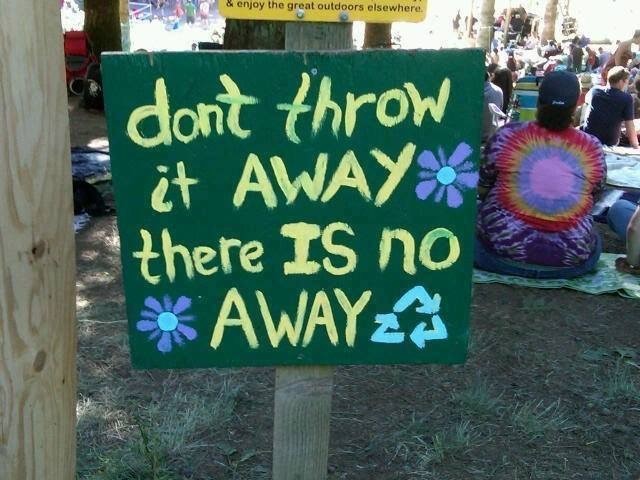

Photo heavy post!
Reduce, Reuse, Recycle – we hear and read it frequently and it makes perfect sense, although sometimes there is a fourth alternative – Upcycling.
Take an item that’s destined for the rubbish and, rather than sending it off to be recycled or disposed of on the tip, make something else out of it, something useful, something amazing and maybe beautiful.
Today’s blog post will focus on upcycling items for the garden but up has no limits almost anything can be upcycled. I have even seen floor mats crocheted from plastic shopping bags giving them a whole new and more functional life.
I love old tools. Many of my favourite tools are old and were repaired or had their handles replaced and are now serving me well. It would be lovely if I could say they were handed down to me from generations of avid gardeners from my family, who lovingly used and cared for them but that is not the case, they instead came to me anonymously without those stories that could have made them more special. They are, however, valued and they continue to work hard. My absolute favourite would be a 3-pronged hay fork. It had a broken handle and was rusty. Once cleaned up and with a new handle attached it has served me well moving straw around my garden and into my chook shed. I use a no-dig method of gardening these days but previously when I enjoyed digging in the garden, I routinely used a hoe to break up the surface and remove weeds such as Paspalum. The hoe was an old one from a clearing sale and it was fabulous to use, perfectly weighted and very effective. I would use a repaired and upgraded garden tool rather than buying a new one as a first option. Once tools are beyond repair they can be upcycled into many fabulous things.
Old garden tools are easy to find at Tip Shops, Recycling Centres, Garage Sales and Clearing Sales. If you are lucky enough to still have curbside rubbish pickups you may be able to spot them on the side of the road (just check that they are not just being rested while their operator is momentarily elsewhere!) They may not be perfect, but they will still have some sort of use. If they are no longer suitable or not needed as working tools, they are perfect for upcycling into garden art. Shovels and spades are the perfect size and shape for decorative animals, add a few other bits and pieces and you could have all sorts of amazing creatures in your garden.
Pinterest is a valuable resource for inspiration. I recently typed in “Shovel Garden Art” and hundreds of examples popped up. Ranging from very simple artworks -shovels with quotes printed on them, to incredibly intricate acid-etched artworks that belong in art galleries not gardens, you would surely be able to find something that suits your artistic skill level. Multiple hours could be wasted oohing and ahhing at the amazing upcycled tools at the very least, even if nothing gets upcycled at your place you will still get enjoyment from old tools.
I wish I could say that the following photo of the colourful spades is my very own work but hey, when the painting genes were being handed out, I was in some other line! This photo was taken by a friend of mine at a market in Egypt. The sign probably says, “No photographs”. One day I am going to create one of these masterpieces, it may not be as special as these, but it will be colourful! I am keeping my eye out at Clearing Sales and the Tip Shop for a Shovel or spade to do just this, even without a handle I think it would look pretty good.
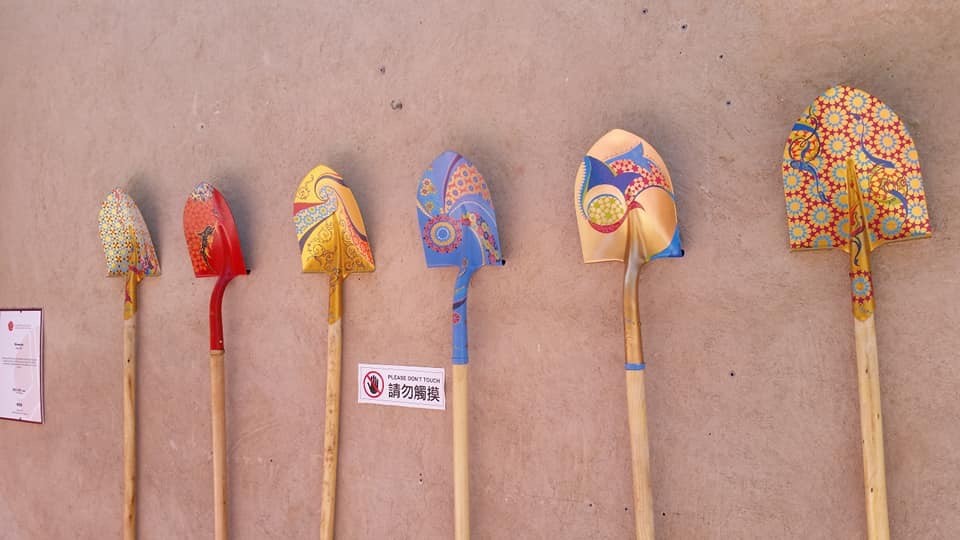
The objects de art (term very loosely applied) below were made by Colin Darts (coincidentally the well-travelled photographer mentioned above). Colin made a number of these as gifts for friends one Christmas. Those of us lucky to receive such a thoughtful hand-crafted present display them proudly.
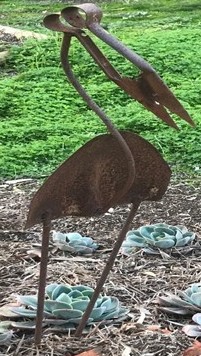
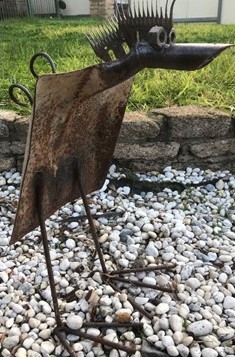
The next one, with the slightly wonky smile, was put together by my husband and graces my garden.
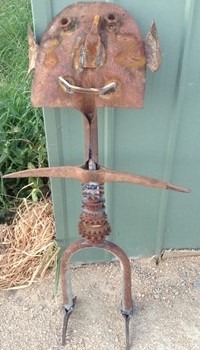
This birdbath/feeder was made from an old glass light fitting. A wreath of willow was woven for it to sit on (this has since dried to a dark brown colour) and string was braided to hang it. Many light fittings have a hole in the bottom of them, but I have found that if you get an old shot glass and attach it over the hole with silicone this will seal it but also adds a central perch for small birds. Fill it up with some flat pebbles or glass beads and you have a bee waterer.
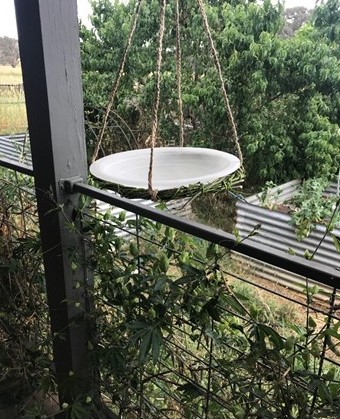
A piece of left-over wood from another project, painted with leftover paint, a few hooks, old soup ladels sourced from tip shops and Op shops wrapped in garden string. Add a small amount of compost and plant with small succulents. Hang it on an external wall for a piece of garden art.
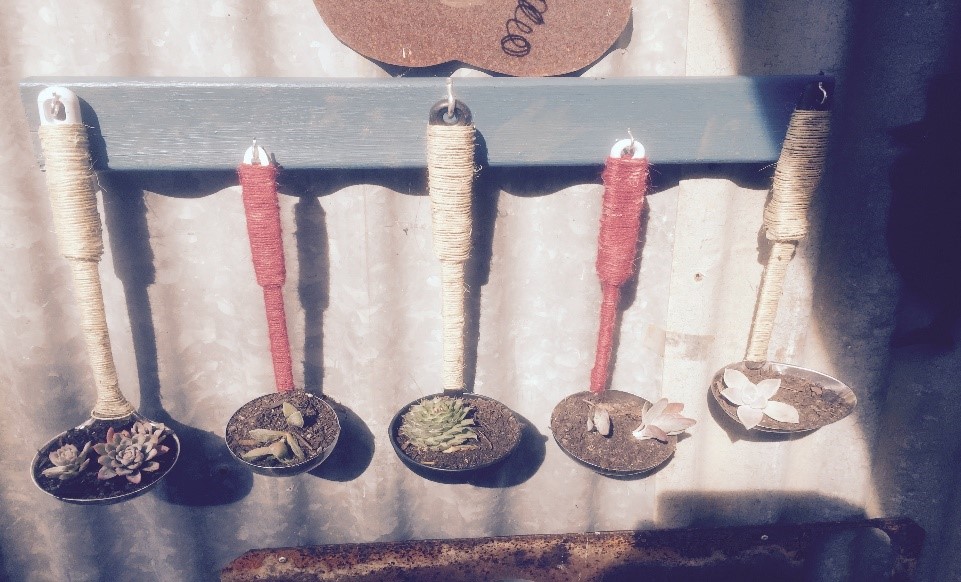
An old wooden step ladder with planks of wood resting on the rungs makes a pot plant display rack. Some of the cups are broken ones that were too colourful to throw away and others were gifts.
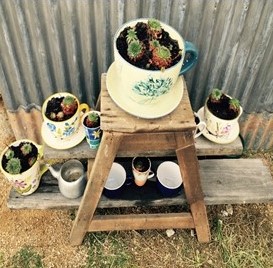
A salvaged toolbox (made by apprentices on rainy days to hone their skills), painted and with a strip of chalkboard paint added to allow for some personalisation makes a great portable herb garden. This one was lined with some surplus black builders’ plastic to protect the wood from excess moisture. It does have some drainage holes drilled into the bottom and corresponding holes in the plastic.

Upcycled pallets could take up an entire blog post by themselves so I will just pop in a couple.
I have found that pallets are available at all sorts of places and usually for no cost. I would recommend asking before just picking them up and taking them, but you will usually get a positive response.
If you need a potting bench you can make yourself one for very little money. One full pallet at the back and another pallet cut in half and then cut off to the height that suits you with an old sink attached across the top. This one is painted because red and white look great and the paint was sitting in the shed, but it looks equally good left unpainted. I also like to paint pallets to give them some protection from the weather. Remember if you are using pallets for any food-related projects try to get the heat-treated ones.
Old sinks are also readily available, sometimes for free and sometimes for a small amount of money. Make friends with someone who does kitchen renovations and you may find you have a steady supply.
A similar process with one whole pallet at the back and two pallets cut down to the required size with a sink attached makes a great kid’s mud kitchen. This one was a Christmas gift and was painted to match a colourful fort that was already in existence. Don’t look too closely at the picture – it is obviously well used and loved. As it is designed to be used with water play, the paint provides additional protection to the pallets and should prolong its life a little.
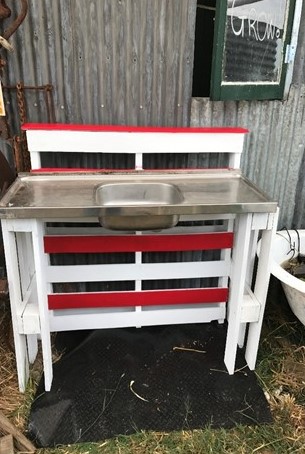
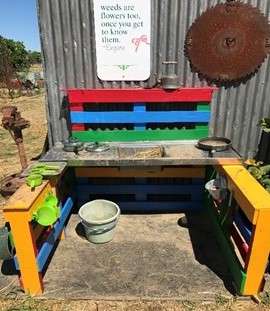
Apologies for the long post I got carried away in my enthusiasm for upcycled garden art and equipment.
Next week part 2 will focus on upcycled projects and pieces that definitely don’t belong in the garden.